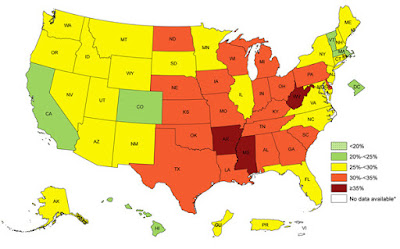 |
Prevalence of Self-Reported Obesity Among U.S. Adults by State and Territory, 2014 |
As obesity becomes prevalent in our country, we begin to face its terrifying consequences even among the young. Historically associated with old age, colorectal cancer is now on the rise among people younger than 50 years of age. A strong warning comes from the finding that in the past 35 years, colorectal cancer incidence has increased among 20- to 34-year olds, and if the trend continues, there will be up to a 90% increase in colon cancer incidence, and 124.2% increase in rectal cancer incidence, in this age group by 2030. Consider that cancer usually takes years to establish; in the case of colorectal cancer, it is believed that it takes at least 10 years for the malignancy to develop. If we do simple math, for 20- to 34-year olds to be diagnosed with colorectal cancer means that the development of cancer started when the individuals were 10 to 24-years old.
Why is the initiation of malignancy occurring at this young age? Why was not this happening 35 years ago? The dramatic shift in age of diagnosis is likely due to the increasing obesity among children (aged 6 to 11) and adolescents (aged 12 to 19). What we eat and how much we move accounts for obesity. It is also likely that the biggest culprit in these past 35 years has been the change in the food industry, as discussed by Dr. Robert Lustig. Since immediate government-initiated steps to revamp the food industry are not in sight, we, the consumers, should be aware of how to protect ourselves and our children from becoming overweight and obese. There are four simple recommendations against childhood obesity, and these should be publicized by all of us. Being knowledgeable about food will not only save our money, but it will also save our lives. Be informed, be in charge of your life.
No comments:
Post a Comment